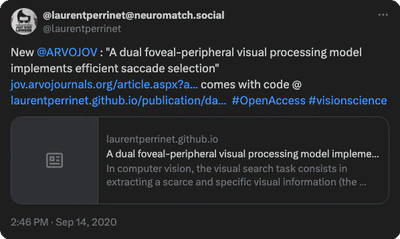A dual foveal-peripheral visual processing model implements efficient saccade selection
Abstract
In computer vision, the visual search task consists in extracting a scarce and specific visual information (the target) from a large and crowded visual display. This task is usually implemented by scanning the different possible target identities at all possible spatial positions, hence with strong computational load. The human visual system employs a different strategy, combining a foveated sensor with the capacity to rapidly move the center of fixation using saccades. Saccade-based visual exploration can be idealized as an inference process, assuming that the target position and category are independently drawn from a common generative process. Knowing that process, visual processing is then separated in two specialized pathways, the where pathway mainly conveying information about target position in peripheral space, and the what pathway mainly conveying information about the category of the target. We consider here a dual neural network architecture learning independently where to look and then at what to see. This allows in particular to infer target position in retinotopic coordinates, independently to its category. This framework was tested on a simple task of finding digits in a large, cluttered image. Simulation results demonstrate the benefit of specifically learning where to look before actually knowing the target category. The approach is also energy-efficient as it includes the strong compression rate performed at the sensor level, by retina and V1 encoding, which is preserved up to the action selection level, highlighting the advantages of bio-mimetic strategies with regards to traditional computer vision when computing resources are at stake.

